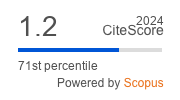The structure of Associative Fields of Stimuli природа / природа / прырода / die Natur in East Slavic and German Languages
DOI:
https://doi.org/10.29038/eejpl.2017.4.1.terKeywords:
image of the world, linguistic consciousness, associative experiment, association, associative field, associative gestalt.Abstract
The problem of the relationship between man and nature, society and nature is of current interest for many sciences. Global processes occurring in the world, also due to human activities, increasingly attract attention of community to the ecology, highlight the fragility of life in general and humans in particular. Thus, the topicality of research is determined by the need to solve the problem of harmonious coexistence of man and nature on the one hand, and the necessity to clarify the awareness of the mentioned issue by each community of people on the other. Psycholinguistic methods of research would help in a study of peculiarities of fragments of world image that hide behind the word "nature" in the linguistic consciousness of different ethnic groups. The objective of the research is the contrastive psycholinguistic analysis of associative fields of words-stimuli природа / природа / прырода / die Natur in order to reveal the general and specific features in images of linguistic consciousness of Ukrainians, Russians, Belarussians and Germans. Attitude to nature was formed by every nation in its own national cultural space, in a historical context, it reflects its value priorities. The material was obtained as a result of series of associative experiments in the early twenty-first century. The respondents were students of higher educational institutions of Ukraine, Russia, Belarus, Germany: 100 representatives from each nation. The material of the free associative experiment is used in this study. Associative fields of word-stimulus природа and its correlates in Russian, Belarusian and German languages were obtained in the result of processing experimental material. Comprehensive contrastive analysis of associative fields was conducted by the method of associative gestalt, that we understand as a solid image, which has a clear structure within the association field. As a result of research we have detected the similarities in the images of linguistic consciousness of Ukrainians, Russians, Belarusians, and Germans that can be explained mainly due to universal human values and differences. The gestalt structure of associative fields in each language clearly demostrate the differences in images of linguistic consciousness. The differences are seen in the different number of zones in four gestalts of studied languages, in the presence of some zones only in certain gestalt unlike others, in size of zones, that define their rating and originality of structure of each associative field, in quantitative and qualitative composition of zones as well as in the cores of gestalts.
References
- Markovina, I., Danilova, Ye. (2000).Spetsifika jazikovogo soznaniya russkikh i amerikants
ev: opit postroyeniya assotsiativnogo geshtalta” tekstovoriginala i perevoda. [Specificity of
the linguistic consciousness of Russians and Americans: the experience of constructing of
the “associative gestalt” of texts of original and translation]. In:
Yazikovoye Soznaniye i Obraz Mira (pp. 116–132), N. V. Ufimtseva, (ed). Moscow:
Institute of Linguistics of the Russian Academy of Sciences.











 Creative Commons «Attribution» 4.0
Creative Commons «Attribution» 4.0